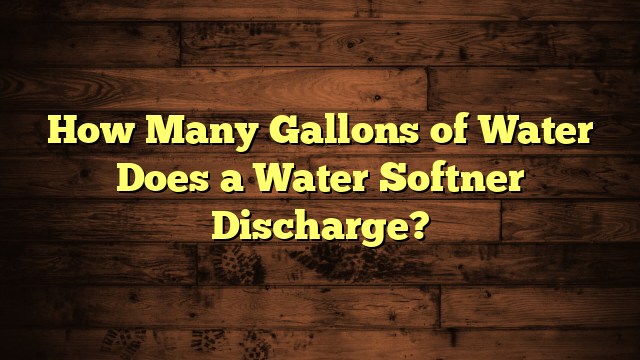How Many Gallons of Water Does a Water Softner Discharge?
When you think about your water softener, it's easy to overlook the amount of water it discharges during its regeneration cycles. Typically, you might see it releasing between 30 to 50 gallons every few days, depending on your household's needs and water hardness. But what does that really mean for your water usage and efficiency? Understanding this process can help you make informed choices about your system. So, what factors influence this discharge, and how can you optimize your water softener for better performance? Let's explore these important considerations further.
Key Takeaways
- A standard water softener discharges between 30 to 50 gallons of water during each regeneration cycle.
- The frequency of regeneration typically ranges from every 2 to 7 days, influencing total water discharge.
- Larger water softeners generally discharge more water during their regeneration cycles compared to smaller units.
- Regeneration frequency and household water usage directly affect the overall water discharge from the system.
- Monitoring and adjusting regeneration settings can help optimize water usage and minimize waste.
Understanding Water Softener Functionality
Understanding how a water softener works is crucial for homeowners looking to improve their water quality. These systems primarily tackle the issue of hardness minerals, like calcium and magnesium, that can wreak havoc on your plumbing and appliances.
When hard water flows through your home, it can lead to scale buildup, reduced efficiency, and even costly repairs.
A water softener uses a process called ion exchange. Fundamentally, it replaces hardness minerals with sodium ions, which are much less likely to cause problems.
As water enters the softener, it flows through resin beads that hold the sodium ions. When the hard water passes over these beads, the calcium and magnesium cling to them, while sodium is released into the water. This exchange greatly reduces the water's hardness, improving your water quality.
You'll notice the benefits almost immediately. Softer water leads to cleaner dishes, softer laundry, and a more efficient water heater.
Plus, it can extend the lifespan of your plumbing system. By understanding this functionality, you can make informed decisions about maintaining a healthier, more efficient home.
The Regeneration Process Explained
When it comes to your water softener, understanding the regeneration process is key to grasping how it works.
You'll want to look at the cycle overview, calculate the water usage, and consider the environmental impact.
Each of these factors plays a significant role in how efficient and effective your system is, so let's break it down together.
Regeneration Cycle Overview
During the regeneration cycle, a water softener cleans itself to maintain ideal performance. This process is vital for ensuring consistent water quality in your home.
There are two main regeneration types: timer-based and demand-initiated. With timer-based systems, the softener regenerates at set intervals, regardless of your water usage. In contrast, demand-initiated regeneration only activates when the system detects a need, optimizing water and salt use.
As the cycle begins, the softener flushes out accumulated minerals, like calcium and magnesium, which cause hardness in water. It then replenishes the resin beads with sodium or potassium ions, making them ready to soften water again. This process not only improves your water quality but also extends the lifespan of your plumbing and appliances.
Understanding the regeneration cycle is essential for maintaining your water softener's efficiency. You'll want to pay attention to how often it regenerates and the type of system you have.
Water Usage Calculation
Calculating water usage during the regeneration process of your water softener is crucial for understanding its impact on your household's water consumption.
Typically, a standard water softener discharges between 30 to 50 gallons of water per regeneration cycle. This quantity can vary based on factors like the size of your unit and your water hardness level.
To determine the exact amount your system uses, check your softener's specifications or consult the manual.
Keep in mind that the regeneration process usually occurs every 2 to 7 days, depending on your water usage efficiency. By monitoring these cycles, you can assess how much water your household is consuming.
Understanding this usage is critical for promoting water conservation. You can optimize your softener for better efficiency, reducing waste while still enjoying soft water benefits.
For example, if your water softener regenerates too frequently, consider adjusting the settings or scheduling it during off-peak times to minimize impact.
Environmental Impact Considerations
While you enjoy the benefits of softened water, it's essential to contemplate the environmental impact of the regeneration process. This process can lead to water pollution and affects resource management in your community. During regeneration, a significant amount of brine, which contains salt, is discharged into the wastewater system. This can contribute to the salinization of local water bodies, disrupting aquatic ecosystems.
To help you visualize these impacts, here's a table outlining the potential consequences:
| Impact Type | Description | Long-term Effects |
|---|---|---|
| Water Pollution | Brine discharge into waterways | Harmful to aquatic life |
| Resource Management | Increased demand for fresh water | Strain on local resources |
| Ecosystem Disruption | Altered salinity levels | Loss of biodiversity |
| Community Health | Contaminated drinking water sources | Health risks for residents |
Factors Affecting Water Discharge
When it comes to how much water your softener discharges, two key factors come into play: the frequency of the regeneration cycle and the size of the water softener.
If you regenerate more often or have a larger unit, you'll likely see higher water discharge.
Understanding these elements can help you manage your water usage more effectively.
Regeneration Cycle Frequency
Over time, the frequency of a water softener's regeneration cycle can considerably impact the amount of water it discharges. If you notice your softener regenerates more often, expect higher water usage.
Generally, water softeners regenerate based on the hardness of your water and the volume of water you consume. When the regeneration frequency increases, the system needs to flush out more minerals, leading to more discharge.
On the other hand, if you're mindful of your water consumption and find ways to reduce it, you might lower the regeneration frequency. This means your softener won't need to work as hard, ultimately decreasing the amount of water it discharges.
It's a balancing act: use water efficiently, and you may extend the time between regeneration cycles.
Keep in mind that settings and efficiency can vary between models. Understanding these factors can help you optimize your water softener's performance and minimize water waste.
Water Softener Size
The size of your water softener plays an essential role in determining how much water it discharges during the regeneration process. Different water softener types come with varying capacities, which directly affects the volume of water used. A larger capacity unit generally discharges more water because it can handle greater loads, while smaller systems might discharge less.
When considering water softener size, think about these factors:
- Household size: More people mean more water usage.
- Water hardness: Harder water requires more frequent regeneration.
- Usage patterns: High demand periods can increase discharge.
- Type of softener: Different types have different capacities.
- Regeneration settings: Manual vs. automatic settings can impact discharge.
Choosing the right water softener capacity guarantees efficient operation and minimizes water waste.
If you have a larger household or live in an area with hard water, investing in a bigger model may save you water and help you avoid frequent regenerations.
Understanding these elements helps you make an informed decision, benefiting both your household and the environment.
Average Water Discharge Amounts
Water softeners typically discharge between 40 and 150 gallons of water during their regeneration cycle. This water discharge can vary considerably based on factors like the size of your softener and the hardness of your water supply.
Generally, larger systems designed for bigger households tend to use more water during regeneration.
So, how does this relate to softener efficiency? A more efficient water softener will require less water for regeneration, meaning it can maintain effective performance while minimizing waste.
If you're choosing a water softener, look for models that advertise high efficiency. They often feature advanced technology, reducing both water discharge and salt usage.
Knowing the average discharge amounts helps you understand the impact on your water bill and the environment.
It's also a good idea to check local regulations or guidelines regarding water discharge, as they may vary by location.
Ultimately, being informed allows you to select a water softener that meets your household needs while promoting responsible water use.
With the right softener, you can enjoy the benefits of softened water without excessive waste.
Environmental Considerations
A water softener's impact on the environment is an important consideration for homeowners. While these systems can improve water quality, they also contribute to water waste and chemical discharge. Understanding this balance helps you make informed choices about water conservation and eco-friendly solutions.
Here are some emotional considerations to ponder:
- The thrill of using softer water for your skin and hair.
- The guilt of wasting precious water resources.
- The peace of mind that comes from making eco-conscious decisions.
- The frustration of dealing with salt discharge in local waterways.
- The hope of a sustainable solution for future generations.
When you weigh the benefits against the environmental costs, consider how every gallon matters. Water softeners use water for regeneration, which can lead to significant discharge. This waste can strain local water supplies and affect aquatic ecosystems.
Opting for eco-friendly solutions, such as salt-free water conditioners or systems that minimize discharge, can help you maintain a balance. By being mindful of your choices, you can enjoy the benefits of softened water while also protecting the environment for you and your community.
Optimizing Water Softener Efficiency
To get the most out of your water softener, focusing on efficiency is key. Start by ensuring regular softener maintenance. Check the salt levels, clean the brine tank, and inspect the resin beads. A well-maintained system not only performs better but also conserves water, reducing waste and costs.
Next, consider the settings on your softener. Many units allow you to adjust the regeneration cycle based on your water usage. If you're using less water, don't hesitate to modify the settings to match your needs. This helps in water conservation while maintaining effective softening.
You should also monitor your water quality regularly. Knowing the hardness level lets you choose the best softener settings, enhancing performance and efficiency. If your water is softer than expected, you might be able to extend the time between regenerations.
Lastly, be aware of potential leaks or issues in your plumbing. Even small leaks can waste water, undermining your softener's efficiency.
Alternatives to Traditional Softening
Evaluating your options for water softening, you might want to explore alternatives to traditional methods. These alternatives can help you manage hard water without the downsides associated with conventional systems.
Salt-free systems and magnetic softeners are two popular choices that might suit your needs.
Here are some reasons to evaluate these alternatives:
- No salt usage: Enjoy soft water without the added sodium.
- Lower maintenance: Spend less time and money on upkeep.
- Eco-friendly: Contribute to a healthier environment by reducing waste.
- Cost-effective: Save on water bills and salt purchases.
- Better health: Maintain essential minerals in your water, which can be beneficial.
Salt-free systems condition water using natural processes, preventing scale buildup without removing minerals.
Magnetic softeners, on the other hand, work by altering the properties of hard minerals, making them less likely to cling to surfaces.
Both options provide effective solutions while reducing the environmental impact and maintenance hassle.
Tips for Sustainable Water Use
Sustainable water use is essential for conserving this precious resource and ensuring it remains available for future generations. One effective way to make a difference is through rainwater harvesting. By collecting and storing rainwater from your roof, you can use it for irrigation, flushing toilets, or even washing clothes. This practice not only reduces your dependence on municipal water but also helps alleviate stormwater runoff, which can harm local ecosystems.
Another technique to contemplate is xeriscaping. This landscaping method focuses on using drought-resistant plants and minimizing water use. By designing your garden with native species, you can create a beautiful outdoor space that requires less irrigation.
Mulching, grouping plants with similar water needs, and using efficient irrigation systems are key components of xeriscaping.
Additionally, simple habits like fixing leaks, using water-saving fixtures, and being mindful of water use while cooking and cleaning can greatly reduce your consumption.
Implementing these strategies not only helps the environment but also saves you money on your water bill. By embracing sustainable water practices, you contribute to a healthier planet for everyone.
Frequently Asked Questions
Can Water Softeners Discharge Water Into Septic Systems?
Yes, water softeners can discharge into septic systems, but you need to check septic system compatibility and local discharge regulations. It's essential to guarantee that your system can handle the extra water without issues.
How Does Hard Water Impact My Water Softener's Efficiency?
Did you know that up to 85% of U.S. homes have hard water? This water hardness affects your softener's performance, making it work harder and less efficiently, leading to higher maintenance needs and costs.
Is Discharge Water From Softeners Safe for Plants?
Discharge water from softeners can harm plant health due to high sodium levels. If you want to protect your plants, consider diverting the discharge away from your garden or using it sparingly for non-sensitive plants.
Do Different Water Softeners Discharge Varying Amounts of Water?
Yes, different water softeners do discharge varying amounts of water. Their water usage and discharge efficiency can greatly differ based on the model and settings, impacting how much water is released during the regeneration process.
How Often Should I Maintain My Water Softener to Reduce Discharge?
Think of your water softener like a car; regular maintenance keeps it running smoothly. Aim for maintenance every six months, and follow maintenance tips like checking salt levels to minimize discharge and improve efficiency.
Conclusion
To sum up, while your water softener plays an essential role in improving water quality, it also discharges a notable amount of water during regeneration. Balancing the benefits of softened water with the environmental impact of this waste is crucial. By understanding its functionality and adjusting usage, you can optimize efficiency and minimize waste. With thoughtful monitoring and a few adjustments, you can enjoy both soft water and sustainable practices, proving that efficiency and conservation can go hand in hand.







